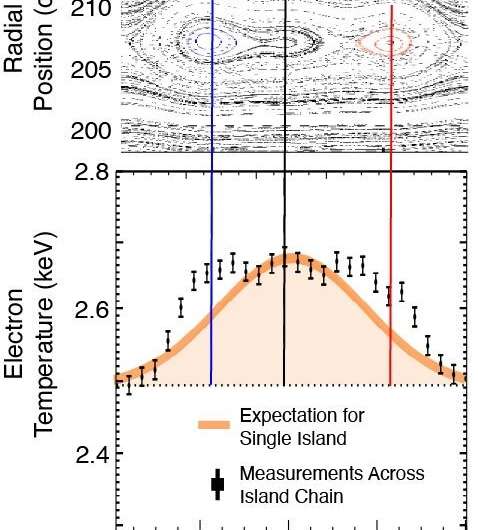Avoiding chains of magnetic islands may lead to fusion paradise

To create the conditions needed for fusion reactions, tokamak reactors contain a plasma in magnetic fields. These magnetic fields can contain tubular areas called magnetic islands. Plasma particles move extra quickly across these islands. This prevents the plasma from reaching the high temperatures necessary for fusion energy production. Fusion plants must therefore minimize the size of these regions. For the first time, researchers have observed the spontaneous formation of a structure in the plasma with multiple magnetic islands. Known as "heteroclinic islands," they do not merge into each other while embedded in a larger magnetic field tube. These structures form areas of higher temperatures at each island center that are directly observed by local measurements. Additional measurements of the magnetic field perturbation caused by these special island chains further confirm their existence in experiments and are consistent with simulation results.
Scientists can stabilize single magnetic islands by driving a current through their center. This stabilizing current effectively destroys the island. Destroying the island allows higher plasma densities and temperatures. In experiments, however, some islands persist even with a stabilizing current. The new observations of heteroclinic islands may explain why. The discovery provides new information for theoretical models that predict the amount of current required to stabilize islands. This information will improve island models. These models will in turn lead to greater confidence in the current drive requirements for future magnetically confined fusion reactor designs. This could ultimately help engineers design more cost-effective reactors.
This work reports the first empirical observations of heteroclinic bifurcation in magnetic islands. Heteroclinic structures can form when magnetic islands with similar geometry and motion form without slipping past each other. Scientists use reconstructions of magnetic field structure to characterize the internal structure of the embedded islands. Scientists derive input parameters for simulations and constrain those simulations from experimental data on the DIII-D National Fusion Facility tokamak. These data agree with the electron temperature profile derived from local data.
These measurements give a clear demonstration that heteroclinic bifurcation of magnetic islands can occur in tokamaks. This phenomenon can be crucial for avoiding island-related energy loss. The plasma current driving the island is split between heteroclinic center-points, and this phenomenon can now be added to theoretical models that describe the ways in which these islands can be stabilized to improve energy confinement. Observing these island chains therefore improves researchers' understanding of plasma behavior in experiments, while also identifying the issues that must be resolved to create better designs for future magnetic fusion devices.
More information: L. Bardóczi et al, Experimental Observation of Magnetic Island Heteroclinic Bifurcation in Tokamaks, Physical Review Letters (2021). DOI: 10.1103/PhysRevLett.126.085003
Journal information: Physical Review Letters
Provided by US Department of Energy





















